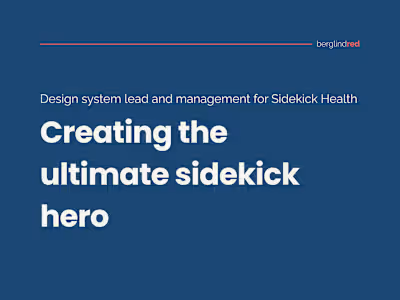Reinventing the Care Management Portal
Introduction
As a Senior Product Designer at Sidekick Health, I was part of a dynamic cross-functional team tasked with redeveloping our care management portal. This platform is crucial for health professionals and care managers at leading pharmaceutical companies like Eli Lilly, Pfizer, and Ypsomed, who rely on it to enhance patient adherence to medical programs and improve health outcomes.
Our team had successfully maintained the older care portal, but it was time to innovate. Our mission was to create an updated platform that not only met user-centric design standards but also addressed the specific needs of health professionals to manage patient care more effectively.
Challenge
The existing portal faced several issues:
It did not reflect the updated brand colors and styles as established in our "Robin" design system.
The platform was not scalable, making it difficult to add new features.
It was UI-driven rather than UX-intuitive, which hindered performance and usability.
Lack of quick actions and "at a glance" overviews increased the time and cost for healthcare professionals to complete tasks.
The increased workload potentially decreased health impact outcomes for end-users, affecting their quality of life and increasing costs for our customers.
Problem Statement
The outdated design and limited functionality of the existing portal were not only costly in terms of development and maintenance but also risked losing our competitive edge and failing to attract new customers.
Hypothesis
Our hypothesis was that by transforming the portal into a more user-centric platform and integrating the "Robin" design system for consistency, we could enhance user satisfaction and operational efficiency. We planned to test this hypothesis through iterative prototyping and user feedback sessions, aiming to achieve the following outcomes:
Achieve a 25% reduction in task completion time for healthcare managers via self-serve services.
Improve adherence and health outcomes rates by 15% for end-users.
Cut operational costs by 20% for customers.
Help healthcare providers boost end-user engagement by 30% and increase Sidekick Health's revenue by 20%.
Design Strategy
Our design strategy aimed to align with our goals by leveraging Tailwind and "Robin" for swift development and design uniformity. We prioritized an intuitive UX to accommodate the busy schedules of healthcare professionals while overcoming technical constraints for rapid delivery.
Extensive user research was conducted, gathering insights from health professionals to grasp their daily challenges and requirements. This research guided our design strategy and prioritized features to maximize value. Benchmarking against leading healthcare management systems helped identify industry standards and best practices that informed our design decisions.
With the overhaul of service and information architecture, we seized the opportunity to enhance scalability, streamline user flows, and integrate new designs or iterations. Our APIs were redesigned for improved robustness and flexibility, supporting a wider range of functions and enhancing system performance.
Next steps
This project remains ongoing and is currently in the design and development phase. We are actively iterating on enhancements, expanding features, and ensuring seamless integration and scalability for future growth and technological advancements.
Learnings
One major insight was the influence of external teams and executive strategies on our project timelines and product roadmap. Despite our team's synergy and agility, external dependencies led to delays and disruptions, highlighting the need for better alignment and communication with all stakeholders.
Gained expertise in stakeholder alignment and communication, vital for navigating external dependencies and ensuring project success
Like this project
Posted Apr 30, 2024
At Sidekick Health, I led a redesign of our care portal, crucial for clients like Eli Lilly and Pfizer, enhancing patient care and outcomes.






